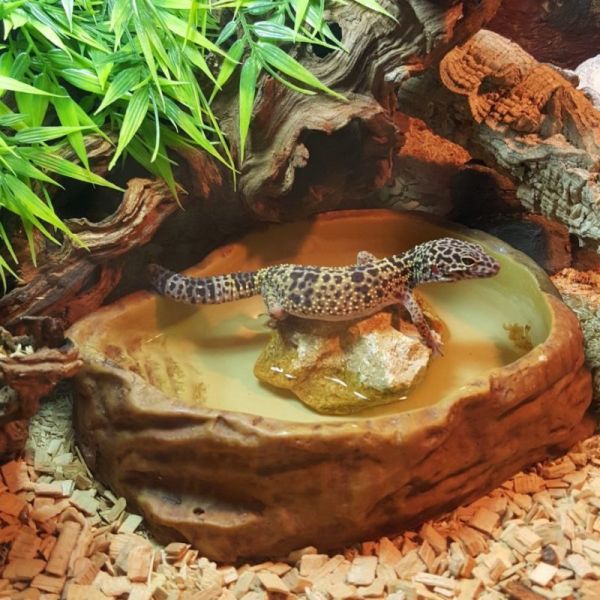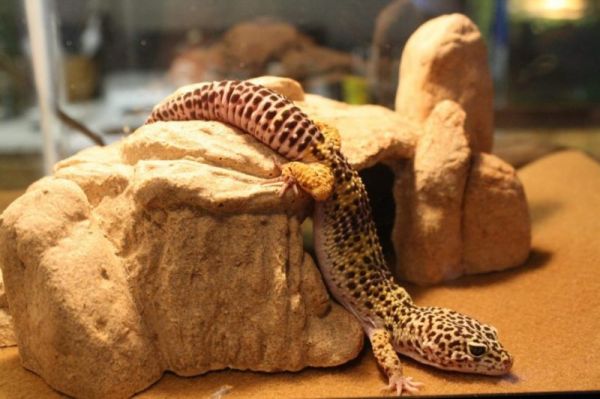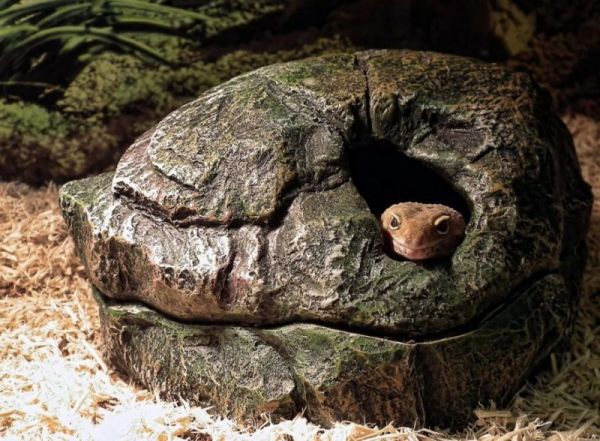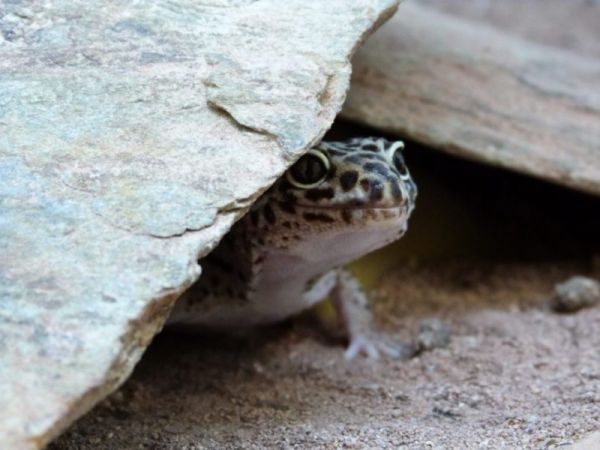Leopard Gecko Enclosure: How to Set Up The Ideal Tank?
Leopard geckos are quite undemanding when it comes to terrarium setups. They don’t need climbing structures, bathing dishes, plants, or huge tanks to feel at home. The ease of designing leopard gecko enclosures has likely contributed to their popularity.
However, leos still need sufficient space, correct substrates, a proper heat source and lighting, functional hides and decoration, and sufficient airflow.
Let’s explore the best setup options. We’re aiming for reptile high life!
Quick List of Essential Leopard Gecko Habitat Requirements
Tank (minimum 20 gallons, 40 gallons preferable) Leopard gecko-friendly substrate Heating equipment (e.g., Deep Heat Projector, heat mat) Thermostat with a thermometer) Lighting (daylight, UVB also highly recommended) Hides (3, 4 preferable) Decoration that forms functional moving, basking, and hiding spaces Water tray Feeding trayThe Leopard Gecko Enclosure
A solid tank will be a basis for your leopard gecko vivarium setup.
Tank Size
The first thing to consider is the tank size.
Here is the list of the most commonly used tank sizes for housing one leopard gecko.
10 gallons (~38 liters) 15 gallons (~57 liters) 20 gallons (~76 liters)As you can see, a 10-gallon tank is the minimum size; however, there is no upper limit, and it’s great if you can give your leo an enclosure larger than 20 gallons.
Another important consideration is the tank shape. Leos are ground geckos and prefer long, relatively shallow tanks, giving them much floor space. Avoid tall and narrow tanks such as those commonly used for chameleons or other tree-dwelling species.
Our Tank Recommendation
Tank Material
A tank you will use for setting up your leo habitat can be made of different materials. I will cover the three most common types: glass, plastic, and wooden tanks.
Glass Tanks for Leopard GeckosGlass tanks are a classic option – and my personal preference. Glass has the highest visibility of all materials, it is chemically stable (doesn’t leach chemicals), and it is easy to clean and disinfect. If thick enough and handled correctly, it is surprisingly durable – a well-kept glass terrarium can look like new for decades.
The downside of glass is that it is heavy and can break. However, because leo tanks are generally not too big, the risk is undoubtedly smaller than for bigger glass terrariums or aquariums.
Another issue with glass tanks is that they can be pricey. Buying second-hand tanks can save you some money.
Plastic Tanks for Leopard GeckosPlastic tanks made out of PVC or ABS plastic have become popular in the hobby because of their durability and adaptability. They are lighter and less prone to breaking than glass tanks, and their sides can be drilled to fit cables and equipment.
Plastic tanks are made from separate plastic sheets or come as professional, one-piece molded terrariums. They are usually expensive, but because leos don’t require massive tanks, you can likely find one for a reasonable price.
The downside of plastic tanks is that the cheaper ones are usually transparent only on the front side, while other sides are opaque. Also, plastic tanks are more prone to scratching, so you have to be more careful when doing maintenance.
Wooden Terrariums for Leopard GeckosBy construction, wooden tanks are similar to more affordable plastic ones. A plywood enclosure will have all sides made out of wood except for the front, which is usually made out of glass. Wooden enclosures are one of the cheapest options and the easiest type to make yourself.
Some reptile enthusiasts wisely turn wooden shelves into terrariums. Because of their size, leopard geckos are especially suitable for bookshelf enclosures, and a bookshelf setup such as this one can save you a lot of time, money, and effort when you are housing many geckos.
The issue with wooden tanks is that wood is porous – it absorbs water, making it prone to rotting and mold and difficult to disinfect. The way to combat this issue is to apply a non-toxic, waterproof coating, such as a pond shield, over the entire wooden surface. It will make it smooth and waterproof and also give it a nice, glossy finish.

Tank Ventilation
Providing adequate ventilation is a must for a terrarium containing leopard geckos, or any other lizards for that matter.
Ventilation in a tank can be passive, active, or a combination of the two. Passive ventilation is the most common – it is simply a mesh that covers the entire lid, a part of the lid, or another upper part of the tank. Active ventilation is achieved through electronic ventilators like those used inside your computer.
Tank Access
There are two main approaches to designing tank access (opening). One is a tank that opens from above, like an aquarium – this approach is more common for small terrariums. The second is tanks that open frontally, in which case the front glass of the terrarium acts as sliding doors.
The tank that opens from the front is a better option for several reasons. It is easier to access and clean, and lizards will be less fearful when you approach them from the front.
Did You Know?
Access from the top can trigger defensive reactions since in natural habitat dangerous predators usually lurk from above.
On the downside, lizards are quicker to escape from enclosures with the front opening. Also, there is a greater chance of accidentally leaving the terrarium open.
You shouldn’t open the tank as a means of ventilating it on a regular basis. The escape risk is simply too great, no matter how docile your leopard gecko looks.

Humidity & Water
Leopard geckos originate from the arid grasslands of Central Asia, so similar conditions should be replicated in captivity. Unlike with tropical geckos, there is no need to mist the entire terrarium.
However, a humid spot in the terrarium is a must. In their natural habitat, geckos will burrow and seek moister and a cooler environment when they need it, and having a humid hide is a way to replicate that.
Humid Hide or Cave
A humid hide has several crucial roles in a leopard gecko tank.
It is a place to rest and gather moisture when needed. It is necessary for complete and healthy skin shedding. It is a place for gravid females to instinctively hide and even lay eggs.You provide a humid hide for your gecko by picking an appropriate and quite enclosed reptile cave or another shelter, putting water-retention substrate like coconut coir, peat moss, or eco-earth inside, and misting it regularly.
Water Source
Geckos also need a shallow water tray in their tanks, preferably made from inert, natural materials (rock, porcelain, thick glass), but safe plastic materials such as epoxy resin are fine, too. The water should be easily accessible for them to lick it (leopard geckos drink water a lot like cats). You should change the water at least every other day.
Temperature
Leopard geckos are ectothermic animals, meaning their body temperature depends on their surroundings. Therefore, you need to provide a fairly constant temperature in their tank and a temperature gradient.
You create a temperature gradient by concentrating heating and basking equipment on one (“hot”) side of the tank, thereby forming a warmer and cooler area within the terrarium. Leos will bask in their hotspot whenever they require additional heat and then cool down in the opposite part once they get too hot.
Did You Know?
The optimum temperature for geckos is 75 to 85°F (~24 to 29°C) during the day, with the basking area going as high as 90°F (~32°C). If possible, the nighttime temperature should be in the 70s (~20-21°C).
There are several ways to provide heat for your leos:
Warmth-emitting daylight/basking lights Deep Heat Projectors (DHPs) Ceramic Heat Emitters (CHEs) Undertank heating padsHeating pads are simple heaters that are put under the tank, providing heat from below. They are inexpensive and don’t waste a lot of power. The fact that they are placed under one part of the tank means that this will allow you to create a much-needed temperature gradient.
Never use heat rocks or any direct heating, as these could burn your gecko’s velvety, sensitive skin.
A thermometer to check the temperature, both in the cooler part of the tank and in the hotspot, is required to be sure that the temperature in the tank is within a good range.
How much you’ll have to invest in heating depends on your room temperatures throughout the year. If your space is already warm enough, e.g., around 75°F (24°C) during the day, installing a quality basking light should be enough to provide optimum temperatures. However, if you live in a colder part of the world or have a reptile room in a basement or garage, you will need additional heaters.
Dive into our ultimate guide on temperature and humidity for leopard geckos.
 Picture by Jessi Swick
Picture by Jessi Swick Lighting
Although historically leopard gecko keepers haven’t provided cage lighting for their pets due to their crepuscular nature, proper lighting is proven to increase the quality of life for leos.
The most up-to-date recommendation is to include both daylight and UVB lights. Here’s why.
Properly managed daylight helps establish a natural circadian rhythm and adjust it depending on the season. It can provide additional heat (if you opt for a 2-in-1 solution) and is necessary for daytime viewing and plant growth.
Halogens and tungstens are suitable options for daylights that emit heat, while warmer compact fluorescent and LED bulbs are suitable choices for providing light only.
UVB or full-spectrum UV bulbs will provide your leos with a natural source of Vitamin D3. It is synthesized inside the lizard’s body, just like under natural sunlight. UV light is one of the best ways to prevent metabolic bone disease (MBD) in leopard geckos.
As leos don’t bask in full sun, choose UV bulbs intended for shade-dwellers (that provide 5-7% of UV).
Night lights such as red, blue, and black bulbs are no longer recommended for lighting terrariums at night. They are all more visible to reptiles than we thought and could negatively impact their circadian rhythm.
Still, if you want to view your leos being active at night, occasionally turning on the red or “black” bulb for a short while won’t do harm.
For more tips and information, have a look at our leopard gecko lighting article.
Substrate
The choice of substrate is a very important question for your pet leopard gecko’s overall well-being. Why is that?
As ground-dwelling lizards, leos spend a lot of time interacting with the substrate in their tank – they will move on it, dig through it, and even lay their eggs in it.
Despite bad advice from some pet shops, choosing a substrate is not as simple as just putting sand in your tank because “geckos come from deserts” – actually, leos do not come from sandy deserts, and pure sand is the worst substrate you could use for your leopard gecko! This especially goes for calcium sand, which is made of pure calcium carbonate and can cause various digestive issues, including deadly impaction.
By accidentally or purposefully ingesting sand, gravel, walnut shells, or other loose indigestible substrates, your leo could face a risk of impaction – a dreaded condition in which gecko’s delicate intestines are blocked by hard matter.
That is why it is very important to choose your substrate carefully!
Luckily, a new generation of well-balanced, natural, low-risk loose substrates has arrived. Thanks to these bioactive-ready substrates, you can now enjoy naturalistic terrariums that are both safe and highly comfy for your leos. Here is a short list of good and bad leopard gecko substrates:
Good and natural substrates: bioactive-ready substrates for desert dwellers (e.g., BioDude Terra Sahara, Arcadia EarthMix-Arid), DIY 70% topsoil, 30% play sand mix, excavator clay. Good but not-so-natural substrates: paper towels, newspaper, ceramic tiles. Bad substrates: Sand, calcium sand, quartz, walnut shells, wood chippings, bark, and other “forest” substrates. Debated substrate: Coconut fiber/eco earth, reptile carpets.Our Substrate Recommendation
My absolute preference is the combination of bioactive-ready loose substrate base and segments of natural solid substrates (slate, tufa, or another suitable rock). Such a setup will give your leopard gecko a naturalistic terrarium ground it will love and enjoy. The Zoo Med excavator clay is a sure bet (see on Amazon)
For more details on each type of substrate and substrate importance in general, check out our article on the best substrates for leopard geckos.
 Picture by Stuart Mckiggan
Picture by Stuart Mckiggan Hide & Decoration
When we say decoration, people usually think about something that has a purely aesthetic value. But in the case of the vivarium, “decoration” is usually the part of the habitat animals will interact with the most.
By the breeder’s recommendation, I bought a terrarium with a stone wall made out of tufa limestone rock. While that wasn’t a perfect option since tufa is quite rough, it turned out as a great way to gain additional space in the terrarium since climbable 3D backgrounds efficiently increase the surface volume your lizards can move on. Though initially more expensive, it has tremendously improved my geckos’ movement ability and level of activity. My pets never suffered an accident because of the roughness of tufa rocks. But nowadays, there are plenty of options for creating smoother and safer backgrounds.
Rocks And Bogs
Rocks and bogs (decorative wood pieces) are essential decoration elements. Using rocks and wood, you can structure your leopard gecko habitat and provide shelter and climbing surfaces. The only important thing is to follow certain safety guidelines.
All structures that you create out of rocks must be firmly attached to other rocks and/or walls of the terrarium. A simple way is to use aquarium silicone glue or another tried-and-tested, non-toxic option.
Also, you should always opt for rocks that lack sharp edges but are not entirely smooth either to provide a decent grip for those cute gecko feet. Slate is an ideal example of that balance. My own experience with quite rough tufa rocks has been excellent, but I would be reluctant to recommend them to anyone because most edges are sharper than slate. Still, it is a soft rock that can be smoothed out. The bottom line is – when deciding what type of rocks to put in your terrarium, use your best judgment.
Hides
Leopard geckos will often rest and cool down in their hideaway. A hideaway, or a hide-box, is a semi-closed structure. It could be a commercial reptile cave or a series of rock and wood structures that a gecko can use for hiding.
3D backgrounds
At the breeder’s recommendation, I bought terrariums with 3D back walls constructed out of tufa limestone rock and concrete. It turned out to be a great way to gain additional space in the terrarium since climbable 3D backgrounds efficiently increase the surface volume your lizards can move on. Though initially more expensive, it has tremendously improved my geckos’ movement ability and level of activity. My pets never suffered an accident because of the roughness of tufa rocks. But nowadays, there are plenty of options for creating smoother and safer 3D backgrounds.
One or two hides?
I recommend having at least two dry hideouts: one in the hot spot and one in the cooler part of the terrarium. This will help your gecko regulate its body temperature during the day and in any situation. For example, a gecko that has eaten well will usually pick a warm hideaway to digest his food.
As for moist hides, ideally, there should be one on each side of the tank, but if you can’t provide that, opt to put one moist hide in the middle of the tank/temperature gradient.

Do Leopard Geckos Need Plants In Their Tank?
Leos do not require any plants in their tanks, living or fake. Still, some of you can’t imagine a natural terrarium setup without any greenery, so let’s explore plant options for a leopard gecko habitat.
Real Plants
Unlike tropical vivaria, most of the real plants can’t thrive in a leopard gecko habitat due to insufficient moisture. Among rare exceptions are the so-called air plants. These alien-looking rootless plants are very low-maintenance and can be attached to walls or rocks. They should be misted once or twice a week and have at least some light.
Some people recommend succulents with no spikes, though it will be difficult in a gently-lit terrarium. Succulents are also sensitive to stale air. They are affordable and can be tried out easily, but they come with some risk of introducing pests.
Artificial Plants
Many setups include artificial plants. It is a matter of personal taste and not a requirement. There are some amazingly realistic artificial plants out there. Elaborate models are prone to getting dusty, so be sure to give them a good wash when you do regular terrarium maintenance.
Bioactive Leopard Gecko Terrariums – Yay or Nay?
Bioactive tank setups seem to be all the rage these days. The concept of a bioactive tank is to make it as naturalistic as possible and able to support living creatures—plants, plus invertebrates such as springtails and isopods that help with tank maintenance (eating the waste). Consequently, bioactive setups require only spot cleaning instead of full tank cleaning.
Does it sound too good to be true? When it comes to leopard gecko tanks and other arid setups, it sort of is. The truth is that springtails and pillbugs need humid environments to thrive, and their sustainable population establishment and survival in dry terrariums are questionable.
Still, a naturalistic setup—one that has all the elements of a bioactive tank but no helper invertabrates or even living plants—is an excellent (if not the best) option for housing leopard geckos.
Now It’s Your Turn
Your leopard gecko will interact with his terrarium environment every hour of every day. That is why a quality set-up is very important for your gecko’s quality of life. I firmly believe that a quality naturalistic setup has been essential to my pet geckos’ 20-plus years of well-being and health. The aesthetic value of a good-looking vivarium as an addition to your living space should not be overlooked either.
Was this introduction to the basics of leopard gecko habitat interesting to read? If yes, feel free to share it.
Do you have anything to add or share about your perfect leo vivarium? Let us know in the comments. We would love to hear from you!
You can find additional tips in our Leopard Gecko Care Sheet
— Main picture by Chris Parker
相关知识
Leopard Gecko Enclosure: How to Set Up The Ideal Tank?
A Comprehensive Guide to Care for a Leopard Gecko
Leopard Gecko Vivarium Set Up
How Long Does A Leopard Gecko Live For –
Leopard Gecko Size: How Big Does a Leopard Gecko Get?
Leopard Gecko Lighting Needs and Requirements
8 Reasons Why Your Leopard Gecko is Not Pooping (And How to Help)
Leopard Gecko Care Sheet
7 Types of Leopard Gecko Poop and Their Meaning
Lavender Leopard Gecko: A Colorful Reptile
网址: Leopard Gecko Enclosure: How to Set Up The Ideal Tank? https://m.mcbbbk.com/newsview675606.html
| 上一篇: 怎么邮寄宠物鱼 |
下一篇: 初次养猫应该如何养 |


